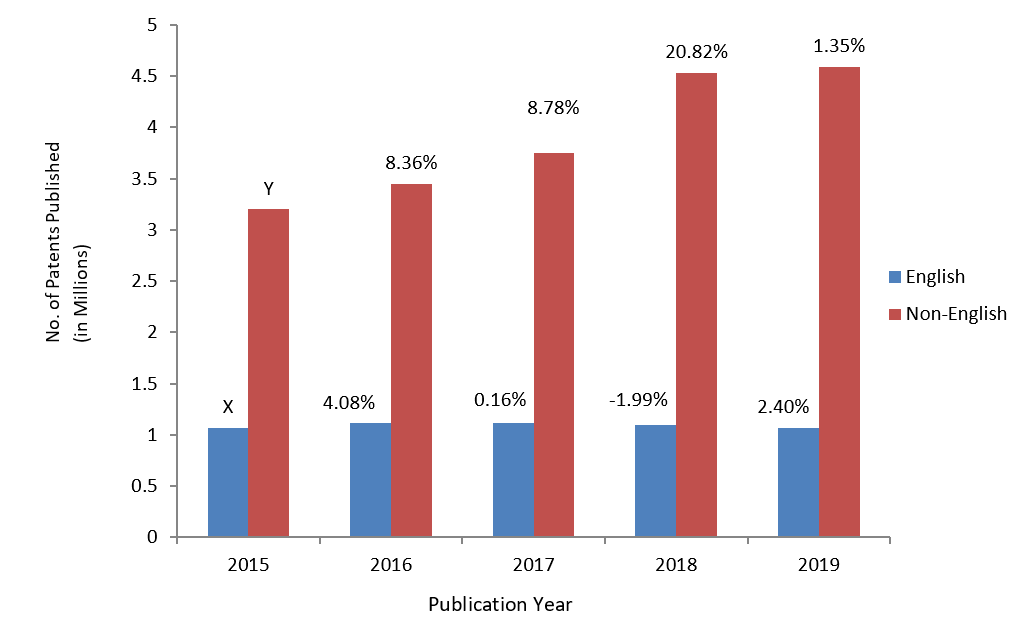The Complete Guide to Searching Non-English Patent Literature
Companies and inventors around the world file patent applications in not one but multiple languages. It is, therefore, imperative for prospective patent applicants to search non-English patent literature while carrying out patent searches to obtain comprehensive search results. Analysts or patent search experts who only understand English require a quick yet accurate translation of non-English patent literature to ensure that they cover the relevant patents. While machine translation sites and databases have improved significantly and are now able to understand and translate patent applications filed in foreign languages, one cannot solely rely on machine-translated texts to provide accurate search results.
In this article, we will discuss non-English patent literature and also throw light on some of the best practices to help you minimize the chances of missing out on an important patent due to the limitations of machine-translated texts.
Table of Contents
Non-English Patent Literature
Patent literature refers to the official publications of various patent offices and includes but is not limited to patent abstract, patent index, and patent specification. Further, contrary to popular belief, not all patent literature is available publicly. For instance, a patent specification in the new application stage may or may not be disclosed.
In terms of language, patent literature can either be available in English or a foreign language as applicants file patents in both English and non-English (native) languages. Data obtained from the Questel Orbit database shows that ten countries (China, US, Germany, France, the Netherlands, Italy, Japan, Korea, Switzerland, and Great Britain) contribute to nearly 75% of the total patents filed around the world. Among these ten countries, eight countries (China, Germany, France, the Netherlands, Italy, Japan, Korea, and Switzerland) prefer filing patents in their native language, i.e., non-English language. Interestingly, out of the total patents filed in these top countries in 2018, nearly 4.5 million patents were filed by non-English patent filing countries and around 1.09 million patents were filed by English patent filing countries. This implies that over 70% of the applications filed by the top ten patent filing countries are in non-English languages.
Patent Publication Trends of Top 10 Patent Filing Nations

*Disclaimer: These results are based on patents published from Jan. 1, 2015 to Dec. 31, 2019.
In the graph above, blue bars represent the patents published in English filing nations such as the US and the UK. Whereas the red bars represent patents published in non-English patent filing nations.
Let us assume that X number of patents were published in English filing countries in 2015. So, there was an increase of 4.08% in 2016, 0.16% in 2017, a decrease of 1.99% in 2018, and an increase of 2.4% in 2019**. This indicates a constant patent publication trend in English filing countries. Whereas if we assume that Y number of patents were published in non-English filing countries in 2015, then we can see an increase of 8.36% in 2016, 8.78% in 2017, 20.82% in 2018, and 1.35% in 2019**. This shows an increasing publication trend in non-English filing countries. As a result, the need for machine translation is also increasing.
**Note: As all the patents filed in 2019 might not be published when these searches were run using Questel Orbit, so the data for 2019 might not be accurate.
How to Ensure Accuracy While Capturing and Analyzing Patents
The process of patent searching is divided into two main steps – capturing patents and analyzing patents. Since both the steps are equally important, it is crucial to strike a balance between them. Failing to capture an important patent or interpreting a patent incorrectly can lead to faulty patent searches. Given below are the ways to ensure accuracy while capturing and analyzing patents:
Ways to Ensure Accuracy While Capturing Patents
Are you wondering how you can ensure accuracy while capturing patents? Well, first, we would recommend using a combination of English and foreign language keywords. For instance, if you are looking for patents in China, your foreign language keyword would be in Chinese. But how do you use a combination of English and foreign keywords when you do not know the foreign language keywords? In such cases, you can use translation sites such as Google Translate. Usually, Google translate shows multiple meanings of a word in a different language. It is, however, important to figure out the meaning that is suitable for your search. Besides using a combination of keywords and translation sites, you must try out all spelling variants of a word while conducting your searches to avoid missing out on relevant patents. For instance, you must perform searches for the word “color” using the two spelling variants – color (US English) and colour (UK English).
Ways to Ensure Accuracy While Analyzing Patents
Formulating an exhaustive search strategy helps in capturing relevant patents accurately. But what should be your strategy for analyzing patents while conducting critical projects such as freedom to operate (FTO) projects?
Well, after you capture all the relevant non-English patents, you need to analyze them carefully. In most cases, you have to rely on machine translation since it is difficult to perform manual translation due to time and budget constraints. In order to ensure accuracy while analyzing patents using machine translation, we recommend comparing machine translations from multiple tools such as Google Translate, Patent Translate in Espacenet, and WIPO Translate. Comparing the results of these three machine translation tools will help you to accurately understand the non-English patents.
Four Approaches for Ensuring Accurate and Exhaustive Searches
One can opt for any one of the following approaches for accurately capturing and analyzing search results:
- Using English Keywords – In the first approach, an English language expert uses English keywords to identify relevant patents as well as to analyze them. This is the most common method of searching for patents.
- Using English and Native Language Keywords – In the second approach, an English language expert uses a combination of English and native language keywords to identify the relevant patents. Thereafter, he/she critically analyzes the results using machine translations wherein the text is converted from a native language to the English language.
- Capturing Results Using English and Foreign Language – In this approach, one person who is an English and foreign language expert, or two people – an English language expert and a foreign language expert can capture the results. Notably, foreign language results are captured from native databases. In either case, the results are analyzed by the English language expert using machine translations.
- Capturing and Analyzing Results Using English and Foreign Language – This is the most exhaustive approach, wherein, an English and a foreign language expert work in close collaboration to identify and analyze the patents. However, a person who is fluent in both English and a foreign language can also identify and analyze the relevant patents.
Interpreting Patent Images in Non-English Patents
In most cases, machine translations accurately translates the images in non-English patents. This is because most non-English terms in these images are short forms for technical terms. However, you may face an issue in understanding longer sentences or longer technical terms used in a flowchart.
Useful Search Databases and Translation Sites in Asian Countries
Some popular patent search databases or translation sites for China are search.cnipr.com, pss-system.cnipa.gov.cn, PatentHub, Patentics, HimmPat, and Search.zldsj.com. Thetoprecommended patent search databases or translation sites for Japan are J-PlatPat, ULTRA Patent, and ATMS/PATENTAN (by Fujitsu) while KIPRIS and WIPS are the popular ones for Korea.
The most recommended non-patent search databases or translation sites for China are CNKI, CQVIP, and Wanfang Data. J-STAGE and CiNii are recommended for Japan while NDLS (National Digital Science Links), DBpia, and KoreaScience are recommended for Korea.
Conclusion
Searching patent literature before filing a patent application or launching a product in the market is an important practice among companies and inventors. Unlike popular belief, not all patents are filed in English language. Since more than half of the patents filed by the top ten patent filing nations in the world are in foreign languages, it is crucial to search non-English patent literature to ensure that you do not miss out on any relevant patents. Conducting such foreign language searches can be difficult for most businesses due to budget and time constraints. Hence, you can avail services from companies such as ours. Sagacious IP offers Foreign Language Search service wherein dedicated foreign language search experts allow you to expand IP rights in new markets while also conducting comprehensive patent searches. Click here to know more about the service and click here for the webinar on the subject.
-Lakshay Sharma (Engineering Searching) and the Editorial Team
Having Queries? Contact Us Now!
"*" indicates required fields




